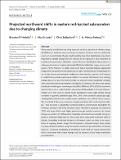Files in this item
Projected northward shifts in eastern red-backed salamanders due to changing climate
Item metadata
| dc.contributor.author | Hedrick, Brandon P | |
| dc.contributor.author | Estrada, Alba | |
| dc.contributor.author | Sutherland, Chris | |
| dc.contributor.author | Barbosa, A Márcia | |
| dc.date.accessioned | 2023-05-04T09:30:12Z | |
| dc.date.available | 2023-05-04T09:30:12Z | |
| dc.date.issued | 2023-04-26 | |
| dc.identifier | 285382926 | |
| dc.identifier | 35855025-387a-436d-96bd-54eb3b628273 | |
| dc.identifier | 37122767 | |
| dc.identifier | 85175315720 | |
| dc.identifier.citation | Hedrick , B P , Estrada , A , Sutherland , C & Barbosa , A M 2023 , ' Projected northward shifts in eastern red-backed salamanders due to changing climate ' , Ecology and Evolution , vol. 13 , no. 4 , e9999 . https://doi.org/10.1002/ece3.9999 | en |
| dc.identifier.issn | 2045-7758 | |
| dc.identifier.other | PubMedCentral: PMC10133384 | |
| dc.identifier.other | ORCID: /0000-0003-2073-1751/work/134491808 | |
| dc.identifier.uri | https://hdl.handle.net/10023/27508 | |
| dc.description | Funding: This work was supported by a research grant to BPH from the Research Enhancement Program at Louisiana State University. AE was funded by Organismo Autónomo Parques Nacionales of Spain through project 2745/2021. | en |
| dc.description.abstract | Many species' distributions are being impacted by the acceleration of climate change. Amphibians in particular serve numerous ecosystem functions and are useful indicators of environmental change. Understanding how their distributions have been impacted by climate change and will continue to be impacted is thus important to overall ecosystem health. Plethodon cinereus (Eastern Red-Backed Salamander) is a widespread species of lungless salamander (Plethodontidae) that ranges across northeastern North America. To better understand future potential lungless salamander range shifts, we quantify environmental favorability, the likelihood of membership in a set of sites where environmental conditions are favorable for a species, for P. cinereus in multiple time periods, and examine shifts in the species' distribution. First, utilizing a large data set of georeferenced records, we assessed which bioclimatic variables were associated with environmental favorability in P. cinereus. We then used species distribution modeling for two time periods (1961-1980 and 2001-2020) to determine whether there was a regional shift in environmental favorability in the past 60 years. Models were then used to project future distributions under eight climate change scenarios to quantify potential range shifts. Shifts were assessed using fuzzy logic, avoiding thresholds that oversimplify model predictions into artificial binary outputs. We found that P. cinereus presence is strongly associated with environmental stability. There has been a substantial northward shift in environmental favorability for P. cinereus between 1961-1980 and 2001-2020. This shift is predicted to continue by 2070, with larger shifts under higher greenhouse gas emission scenarios. As climate change accelerates, it is differentially impacting species but has especially strong impacts on dispersal-limited species. Our results show substantial northward shifts in climatic favorability in the last 60 years for P. cinereus, which are likely to be exacerbated by ongoing climate change. Since P. cinereus is dispersal-limited, these models may imply local extirpations along the southern modern range with limited northward dispersal. Continued monitoring of amphibians in the field will reveal microclimatic effects associated with climate change and the accuracy of the model predictions presented here. | |
| dc.format.extent | 14 | |
| dc.format.extent | 3070891 | |
| dc.language.iso | eng | |
| dc.relation.ispartof | Ecology and Evolution | en |
| dc.subject | Conservation | en |
| dc.subject | Biogeography | en |
| dc.subject | Ecological niche models | en |
| dc.subject | Favorability | en |
| dc.subject | Fuzzy logic | en |
| dc.subject | Plethodon | en |
| dc.subject | Plethodontidae | en |
| dc.subject | Species distribution models | en |
| dc.subject | DAS | en |
| dc.subject | SDG 13 - Climate Action | en |
| dc.subject | MCC | en |
| dc.title | Projected northward shifts in eastern red-backed salamanders due to changing climate | en |
| dc.type | Journal article | en |
| dc.contributor.institution | University of St Andrews. Statistics | en |
| dc.contributor.institution | University of St Andrews. Centre for Research into Ecological & Environmental Modelling | en |
| dc.identifier.doi | https://doi.org/10.1002/ece3.9999 | |
| dc.description.status | Peer reviewed | en |
This item appears in the following Collection(s)
Items in the St Andrews Research Repository are protected by copyright, with all rights reserved, unless otherwise indicated.

